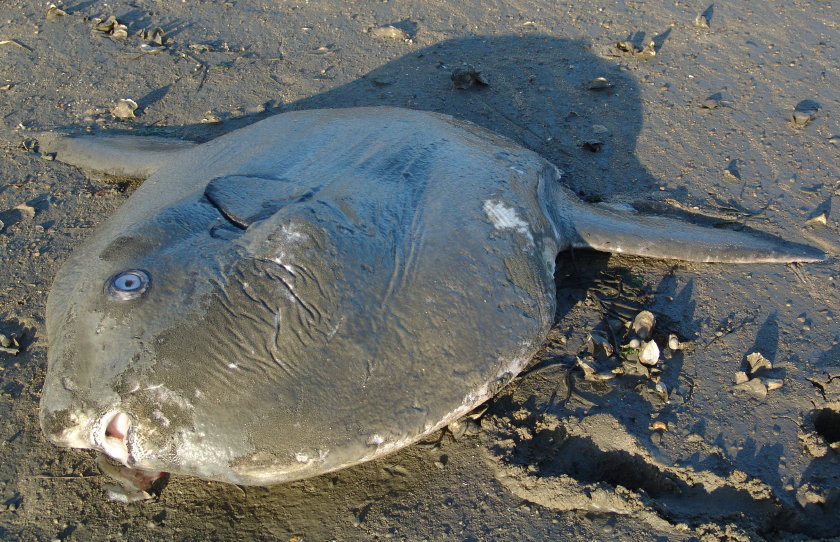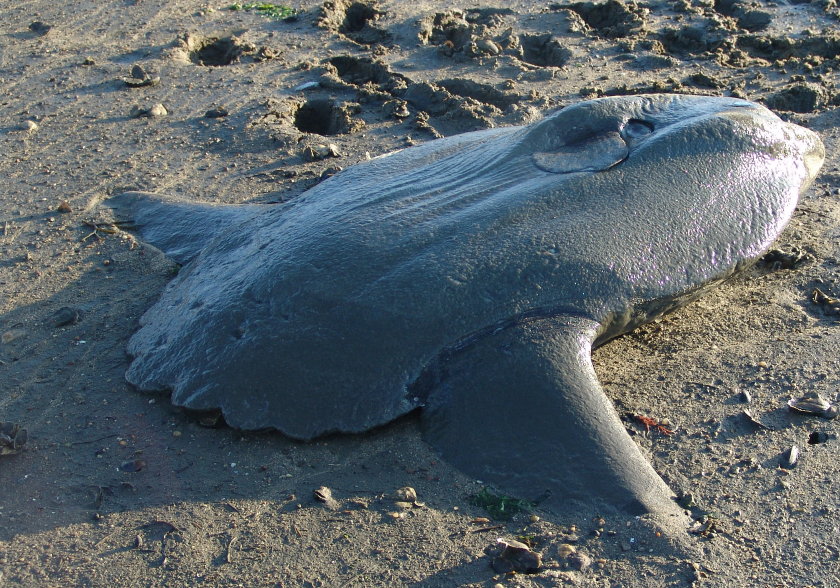This week we have witnessed an exotic array of species from a large blue shark to a rafter of wild turkeys. But when it comes to bizarre, nothing in our corner of the universe matches the ocean sunfish (Mola mola). It’s the most massive bony fish in the world. [Yep. That “bony” adjective excludes sharks (cartilaginous) and, of course, the “fish” category cuts out whales and dolphins (mammals) and giant squid (cephalopods) and even our favorite sea serpent: Nessie. Doesn’t seem fair.] Researchers in the Pacific claim that they have documented an ocean sunfish that reached 14 feet (from dorsal fin tip to anal fin tip) and 10 feet long from face to caudal fin, and hit the scales at near 5000 pounds.
Ocean Sunfish (Mola mola) – Dorsal Fin Left, Caudal Fin Top, Anal Fin Right
That’s right: nearly round, flat and awfully heavy … like a millstone and voilà , the Latin word for millstone is “mola.” Yet, un-millstone like, the ocean sunfish swims lithely through the water not flat like a flounder, but upright with its dorsal fin topside and its anal fin beneath. As the sunfish cuts through the ocean, its dorsal fin often prompts shouts of “shark” from nervous observers. Sunfish are also known to bask motionlessly on the surface for thermoregulation (a.k.a., to warm up).
Ocean Sunfish (Caudal Fin Left, Dorsal Fin Bottom, Face Right)
We often see ocean sunfish in the late summer and early fall along the Outer Cape and unfortunately, and for some reason that we can only speculate about, we find several dead, stranded sunfish each year at the beginning of the cold-stunned sea turtle season. Sunfish inhabit temperate and tropical waters and seem to prefer warmer temperatures, so perhaps they too become cold-stunned during the fall as water temperatures plunge in the Cape Cod region. Perhaps they, too, seek refuge in shallower, warmer bay waters, only to succumb to the cold as the fall chill deepens.
Bob Prescott, the director of Mass Audubon’s Wellfleet Bay Wildlife Sanctuary, was interviewed by Matthew Belson, New Media Editor of Gatehouse Media New England – Cape Cod Region, recently about ocean sunfish that have turned up in Cape Cod waters. Bob, as usual, gives an outstanding overview of the sunfish and its natural history. Click here to listen to Bob’s interview.
Family Examines Ocean Sunfish on Shirttail Point, Wellfleet
Earlier last week a sunfish was spotted swimming erratically in Wellfleet Bay and last Friday an observer reported a dead sunfish by Shirttail Point (the Wellfleet town pier). On Sunday morning when a necropsy was scheduled, the sunfish had disappeared, dragged off by astronomical tides. It surfaced again Sunday afternoon as the tide dropped on a sandy spit at the easternmost point of Shirttail Point. As size goes, this one was smaller than most that we have seen, measuring perhaps 3.5 feet in diameter, excluding dorsal and anal fins. You can get a good sense of its size in comparison to the tourist family in the picture above.
Click Here to View Video in High Quality
Ocean Sunfish
The ocean sunfish is a round, flat fish with a very small, scalloped caudal (rear) fin called a “clavus” (rudder). It has very pronounced dorsal (top) and anal (bottom) fins, but small, obscure pectoral fins that are rounded and directed upwards. The eyes and mouth are relatively small, and the protruding mouth contains fused teeth. The gill slits are covered with an operculum and are found just anterior (forward) of the pectoral fins. Its scaleless skin is thick and helps to protect the sunfish from stinging barbs of jellyfish, one of its favorite foods. The sunfish preys on jellyfish, plankton, crustaceans, small fish, squid and sponges. Its predators include sharks, orcas, and humans that consume Mola mola, especially in the Far East.
 Ocean Sunfish (Eye, Operculum Covering Gill Slits, & Pectoral Fin Facing Upward)
Satellite pop-up tags are used by researchers to understand the movement and the migration of ocean sunfish. They reveal that sunfish stay in the same general geographic area, and that they move up and down the water column many times a day, dropping to 350 meters below the surface to hunt prey. They appear to get cold at depths, which probably accounts for surface basking. Sunfish are know to carry a large parasite load and have “cleaning stations” for other fish and seagulls to lend a helping hand. They also are known to leap from the surface and slap down hard again, maybe to rid the sunfish of pesking parasites … or perhaps merely for sheer exhilaration.
Fun factoid:Â As adolescents, ocean sunfish school, but as adults they are solitary animals.
Keeping an Eye on Ocean Sunfish
Request for Your HelpÂ
NEBShark (the New England Basking Shark Project) in collaboration with the New England Coastal Wildlife Alliance wants to receive sightings of live and dead basking sharks & ocean sunfish. You can report a sighting directly on the NEBShark website, www.nebshark.org, and attach digital images of the animal. Information on these amazing critters, two of the largest fish in the world, is shared with governmental officials and researchers worldwide. “Krill” (Carol) Carson of NEBShark offers her cell phone number (508-566-0009) for live sightings of animals in distress, so that the sunfish can receive expeditious help. If the ocean sunfish is dead, Krill and her colleagues would like to conduct a necropsy to determine the cause of death and to collect tissue samples for genetic and scientific analysis. As you have read before, you can always call our Turtle Journal 24/7 hotline, 508-274-5108, for any distressed critter, for any unusual coastal happening or for information about any wildlife sighting.





[…] Turtle Journal Saving the World, One Turtle at a Time « Exotic Ocean Sunfish (Mola mola) […]
[…] appeared with traffic-stopping effect along the main Outer Cape highway in Eastham. An exotic ocean sunfish stranded at the end of Shirttail Point in Wellfleet Harbor. And harbor seals seem to have moved […]
[…] For more information about pelagic ocean sunfish, see our post Exotic Ocean Sunfish (Mola mola). […]
[…] ocean sunfish (Mola mola) joined the castaways as reported in Turtle Journal on November 1st [Exotic Ocean Sunfish (Mola mola)] and November 12th [Two Giant Ocean Sunfish Wash Up on Cape Cod Beaches].  The team confirmed the […]